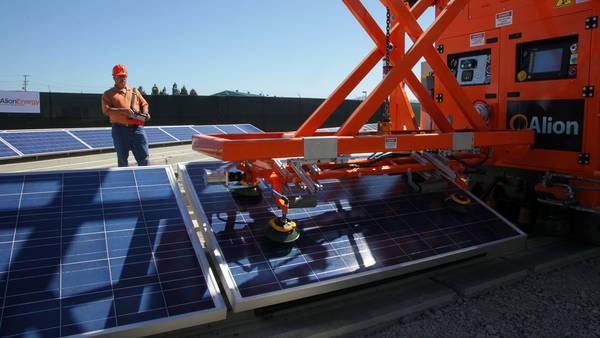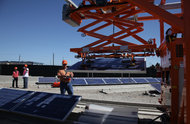| |
http://www.nytimes.com/2013/10/15/business/energy-environment/putting-robots-to-work-in-solar-energy.html?hpw

Published: October 14, 2013
A Staff of Robots Can Clean and Install Solar Panels

The Solar Robots: A California company thinks robots that can install and clean thousands of solar panels may make solar energy competitive with fossil fuels.
By DIANE CARDWELL
RICHMOND, Calif. — In a dusty yard under a blistering August sun, Rover was hard at work, lifting 45-pound solar panels off a stack and installing them, one by one, into a concrete track. A few yards away, Rover’s companion, Spot, moved along a row of panels, washing away months of grit, then squeegeeing them dry.
Enlarge This Image

Jim Wilson/The New York Times
Rover, a robot, placing a solar panel in a track at Alion Energy, which is looking to shave labor costs.
But despite the heat and monotony — an alternative-energy version of lather-rinse-repeat — neither Rover nor Spot broke a sweat or uttered a complaint. They could have kept at it all day.
That is because they are robots, surprisingly low-tech machines that a start-up company called Alion Energy is betting can automate the installation and maintenance of large-scale solar farms.
Working in near secrecy until recently, the company, based in Richmond, Calif., is ready to use its machines in three projects in the next few months in California, Saudi Arabia and China. If all goes well, executives expect that they can help bring the price of solar electricity into line with that of natural gas by cutting the cost of building and maintaining large solar installations.
In recent years, the solar industry has wrung enormous costs from developing farms, largely through reducing the price of solar panels more than 70 percent since 2008. But with prices about as low as manufacturers say they can go, the industry is turning its attention to finding savings in other areas.
“We’ve been in this mode for the past decade in the industry of really just focusing on module costs because they used to be such a big portion of system costs,” said Arno Harris, chief executive of Recurrent Energy, a solar farm developer, and chairman of the board of the Solar Energy Industries Association. Now, Mr. Harris said, “Eliminating the physical plant costs is a major area of focus through eliminating materials and eliminating labor.”
Modules dropped to 35 percent of system costs in 2013, down from 53 percent in 2010, while labor, engineering and permitting rose to 15 percent from 9 percent in the same time period, according to Greentech Media, which tracks the industry.
For all that the industry promotes its innovations, the business of mounting panels on the ground has remained largely the same for years, a process adapted from smaller rooftop arrays that use metal racks to hold the panels in position. In an expensive, time-consuming process that can demand hundreds of hands and millions of screws, workers clear and level the ground, drive in metal posts and attach and wire the heavy, glass-encased modules. Projects can frequently run into delays when, say, the wrong bolts show up at the site.
After the panels are installed, it can be expensive to keep them free of the dirt or growing vegetation that can block sunlight and reduce their output. That task often falls to crews of workers driving along the rows of panels, which can stretch for miles, to clean or trim around each one.
Several companies are developing or selling robots to aid in installation or cleaning, including the Swiss outfit Serbot, which makes robots that can wash the windows of glass skyscrapers as well as clean solar arrays.
Another start-up based in California, QBotix, has developed a robot that controls tracking operations, moving along an array and tilting the panels to follow the sun and maximize their output. Getting as much as 40 percent more electricity out of each panel than in a fixed-tilt system, said Wasiq Bokhari, the company’s chief executive, allows developers to build smaller, cheaper systems to meet their energy production targets.
“The solar market is very competitive, and people literally fight over single cents per watt, so by allowing such a dramatic decrease in overall power plant costs, we are bringing a lot of value to the market,” he said. The systems are now installed in five farms in the United States and Japan, with more scheduled to go in before the end of the year.
Alion’s installation system is designed to work on uneven ground, executives said, cutting down on the need to level acres of fields. First, a machine used to lay sidewalks and gutters spits out a long concrete track. After the track sets, Rover, which resembles an industrial warehouse cart on caterpillar tracks, installs the panels and glues them in place. Human workers then wire the panels into the system.

Mark Kingsley, right, Alion’s president, with Jesse Atkinson, vice president for marketing.
Spot can be controlled with a smartphone and runs on a solar-powered battery. It rolls along the rails beneath the panels, squirting water and passing over them with a spinning brush and a squeegee. It also has a standard hedge trimmer attachment that can cut vegetation from the ground.
The promise of automation is not only to reduce the cost of labor, but also to cut construction time — to 12 weeks from six to eight months in some cases — which also reduces the amount of time developers would be accumulating interest on a loan, said Mark Kingsley the chief executive at Alion.
“Like most industries, when you really do disruptive change of cost, you change materials and you change design concept,” said Mr. Kingsley, who was chief commercial officer of the Chinese panel-maker Trina Solar and led the robotics unit at ABB, a Swiss power and automation technology giant. “And that’s what we did: we changed materials from steel to concrete and we changed the methodology from manual to automation.”
The company has attracted some positive attention from analysts. “What’s exciting with Alion is that they’ve automated the entire process,” said Vishal Sapru, energy and environment research manager at the business consulting firm Frost & Sullivan, which recently gave Alion an award for innovation. “You reduce the number of days. You reduce the number of laborers. You reduce the number of inefficiencies that could arise in putting up these panels, and then it results in a huge cost savings.”
He cautioned that it was unclear precisely how much the technology would save — the company says it can reduce overall installation costs by 75 percent, while German companies that do similar work put their estimates closer to 50 percent, Mr. Sapru said. But he said that whatever the savings, it would benefit the industry and help relieve the price pressure on solar panel manufacturers.
Back at Alion’s headquarters, efforts to squeeze even more expense out of the system continue. A leaner, more nimble model of Rover that requires less concrete — known as the Jackal for now — lies in wait, while a second-generation Spot is in the works.
“The goal is not robotics,” but to beat the price of natural gas, Mr. Kingsley said, as the machines continued moving inexorably along the south-facing rows, with the panels Spot cleaned suddenly producing about 12.5 percent more electricity. “You have to be lean and pretty low cost to meet that.”
|
|

